Overview
The article titled "10 Essential Tips for Supporting a Niño con Autismo" offers invaluable strategies for caregivers dedicated to effectively supporting children with autism. It highlights the significance of establishing structured routines, employing visual aids, remaining flexible, and nurturing communication. These strategies are not just suggestions; they are backed by research demonstrating that such approaches can profoundly enhance the well-being and development of children on the autism spectrum.
As caregivers, understanding the unique challenges faced by children with autism is essential. By creating a consistent environment, we can help these children feel secure and understood. Visual aids can serve as powerful tools, making communication clearer and more accessible. Flexibility in routines allows for adaptability, accommodating the varying needs of each child.
Fostering open lines of communication is crucial. It not only helps children express themselves but also strengthens the bond between caregiver and child. Remember, every small step taken towards understanding and support can lead to significant improvements in their lives.
If you’re looking for more resources or community support, consider reaching out to local organizations or online forums where you can share experiences and gain insights from others on this journey together.
Introduction
Navigating the journey of raising a child with autism can be both rewarding and challenging, often requiring a wealth of knowledge and support. ASD Media stands at the forefront of this endeavor, offering invaluable resources and insights tailored to empower parents and professionals alike.
Imagine establishing daily routines that enhance predictability or creating sensory-friendly spaces that promote comfort—these strategies outlined by ASD Media aim to foster an environment conducive to growth and understanding.
By prioritizing effective communication, collaboration with educators, and self-care for caregivers, families can unlock the full potential of their children. Together, we can build a supportive community that thrives on shared experiences and collective wisdom.
What strategies have you found helpful on this journey? We invite you to share your experiences and insights with us.
About ASD Media: Empowering Parents of Children with Autism
At ASD Media, we are deeply committed to enhancing the implementation of ABA therapy, providing valuable industry insights and strategies to help overcome challenges and improve outcomes. Our diverse array of resources and assistance is designed for caregivers and professionals in the field, fostering a nurturing and inclusive community. Here, individuals can share their experiences, learn from one another, and find the support they need on their journey.
By subscribing to our newsletter, you can stay updated on the latest news and gain unlimited digital access to our resources. We aim to empower parents and professionals alike, unlocking the potential of youth with ADHD. Our effective strategies focus on:
- Managing difficult behaviors
- Navigating support services
- Enhancing social skills development
Join us in this journey of growth and understanding, and together, let’s make a difference.

Establish a Daily Schedule: Enhance Routine and Predictability
Establishing a daily timetable is vital for a niño con autismo, as it helps him understand what to expect throughout the day. This predictability can significantly alleviate anxiety and enhance their ability to complete tasks. Parents are encouraged to incorporate regular times for meals, therapy, school, and bedtime, while striving to minimize disruptions to this routine.
Visual schedules can also be beneficial for a niño con autismo, as they help the child see the day's planned activities. However, it’s essential to acknowledge that families may encounter challenges related to immigration status, language barriers, or cultural differences, which can impact the effectiveness of these strategies.
Research indicates that predictable routines not only reduce stress for caregivers but also empower children to navigate their day with confidence. Statistics reveal that a niño con autismo who utilizes visual schedules experiences improved task completion and reduced anxiety levels.
Furthermore, promoting diversity and inclusion in services for individuals on the spectrum is crucial to ensure that all children, regardless of their background, have equitable access to these helpful strategies. By considering cultural and linguistic factors, we can enhance the effectiveness of daily routines for individuals with developmental differences.
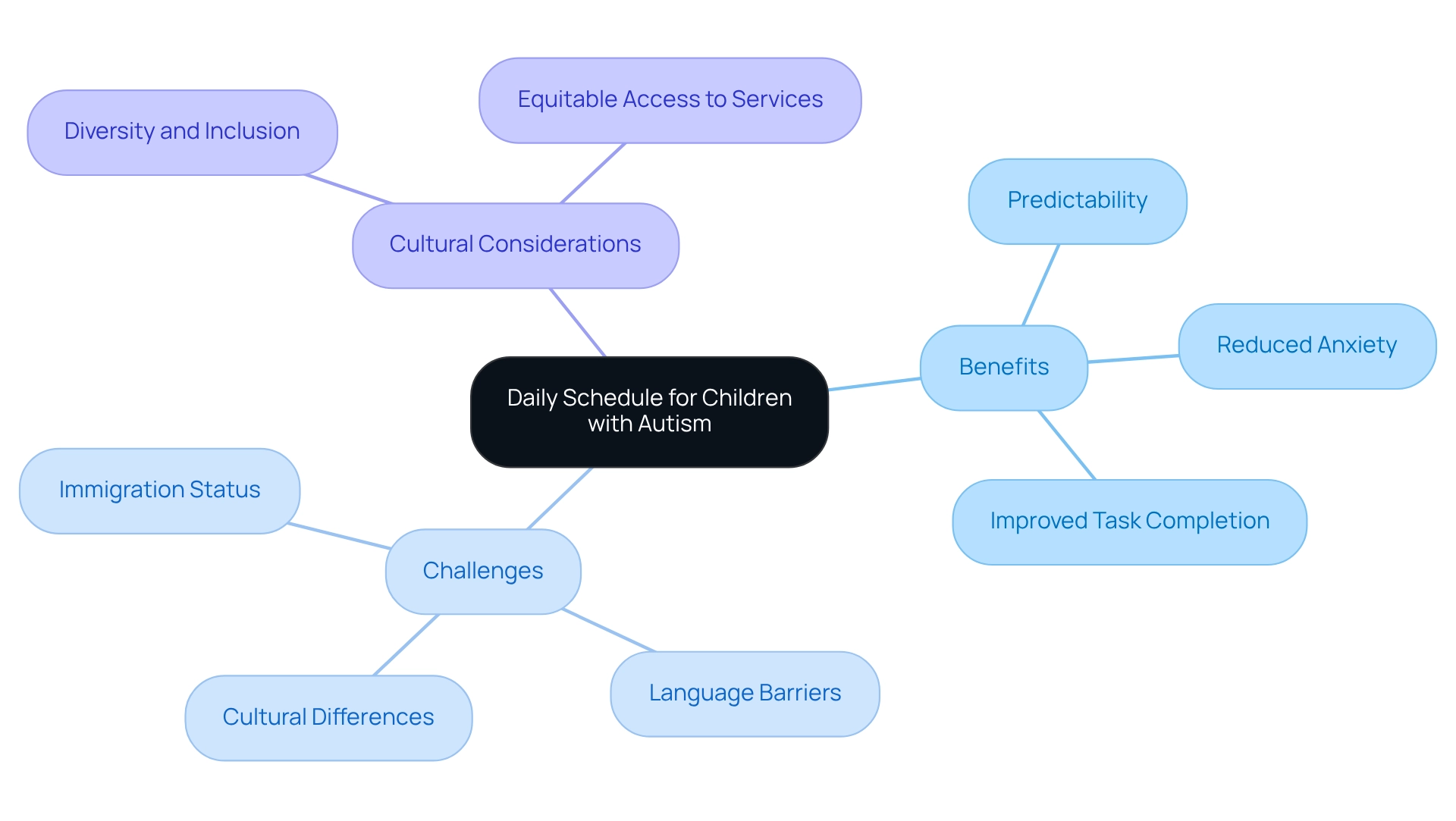
Use Visual Supports: Improve Communication and Understanding
Visual aids, such as picture schedules, charts, and symbols, are essential tools that significantly enhance communication for a niño con autismo. These resources not only clarify expectations and routines but also empower young individuals to express their needs and emotions more effectively. For instance, studies reveal that utilizing visual aids can greatly improve comprehension, allowing young individuals to navigate social situations with greater confidence.
Parents have the opportunity to create personalized visual aids that depict daily activities or emotional states, fostering a clearer connection between their child's experiences and their ability to communicate. The effectiveness of these supports is reinforced by experts who emphasize their crucial role in bridging communication gaps. As Danita M. Luzadder, an autism educator and parent of a neurodiverse individual, poignantly states, "What a shame because as an adult, I MUST have organization, calendars, computer reminders, alarm clocks, and Post-It Notes to remember what to do and when." This perspective underscores the vital importance of organization and visual aids in enhancing communication.
As we look ahead to 2025, the benefits of picture schedules are increasingly recognized, with statistics showing that youngsters who utilize these tools demonstrate improved comprehension and engagement. Research indicates that these visual aids can enhance communication abilities by as much as 40%. Furthermore, case studies illustrate that employing visual supports not only aids in communication but also cultivates a more organized and predictable environment, which is especially important for a niño con autismo. The case study titled "The Science Behind Applied Behavior Analysis" further supports the theoretical framework for using visual aids in ABA therapy. By integrating visual tools into daily practices, guardians and teachers can create a nurturing environment that promotes growth and understanding, while also celebrating the unique creative talents often associated with this condition.
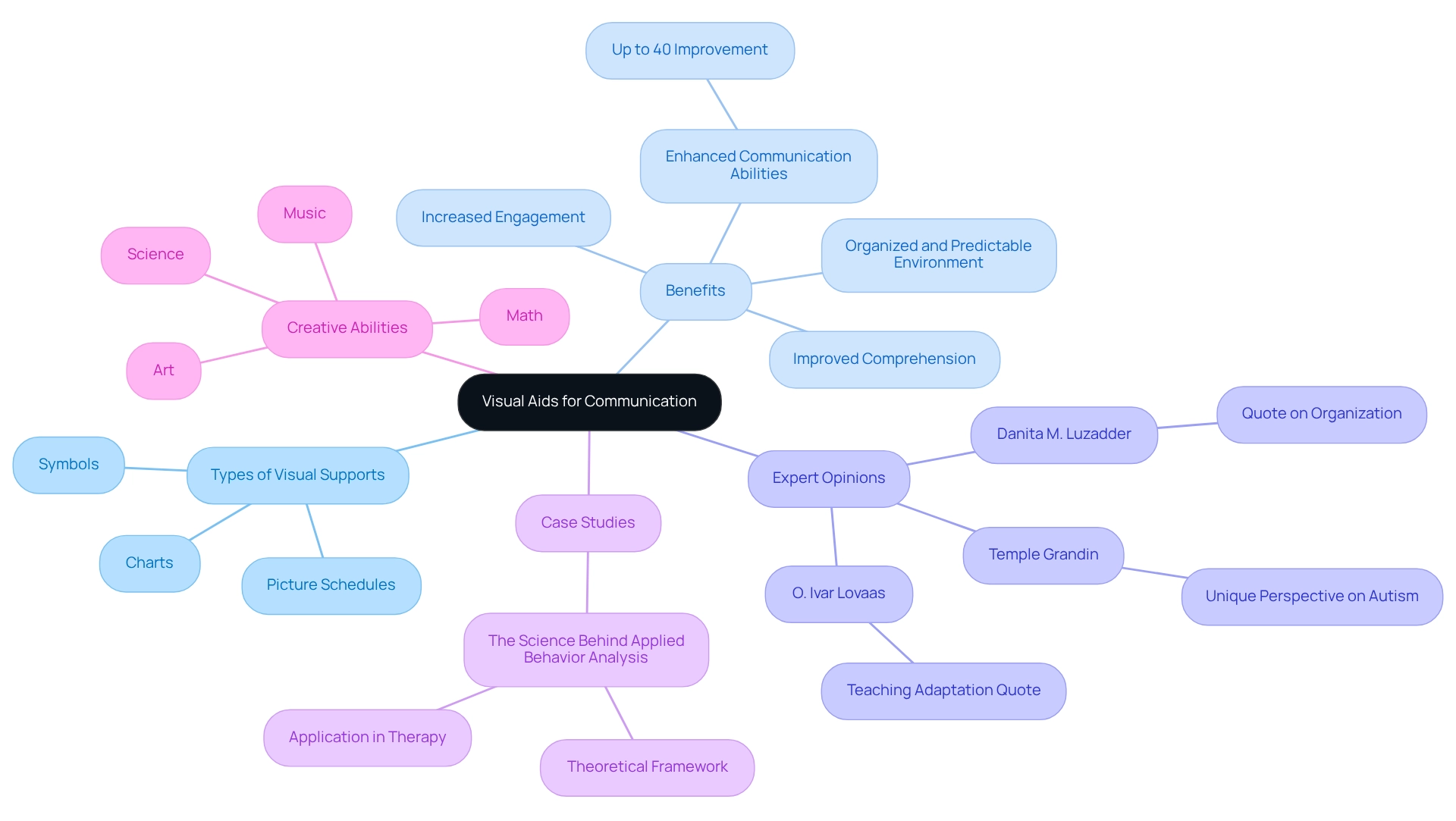
Maintain Consistency and Flexibility: Balance Structure with Adaptability
While consistency is essential for a niño con autismo, nurturing flexibility is equally important. Life's unpredictability teaches young individuals how to adjust to changes, fostering resilience along the way. Parents are encouraged to create a structured environment that still allows for necessary adjustments. Celebrating small victories when children successfully navigate changes reinforces their coping skills and encourages adaptability.
Research indicates that nearly 42.9% of caregivers utilize CBD products primarily to manage anxiety in niño con autismo, underscoring the significance of effective emotional regulation methods. Furthermore, Claudia Lage's meta-analysis highlights cognitive flexibility difficulties in niños con autismo, emphasizing the need for tailored strategies in teaching adaptability. Studies on cognitive flexibility reveal that understanding semantic and phonemic features can enhance assessment approaches, indicating a strong need for personalized strategies.
By balancing structure with flexibility, caregivers can empower their children to thrive in various situations. This approach not only supports their development but also fosters a sense of confidence as they navigate the complexities of life.
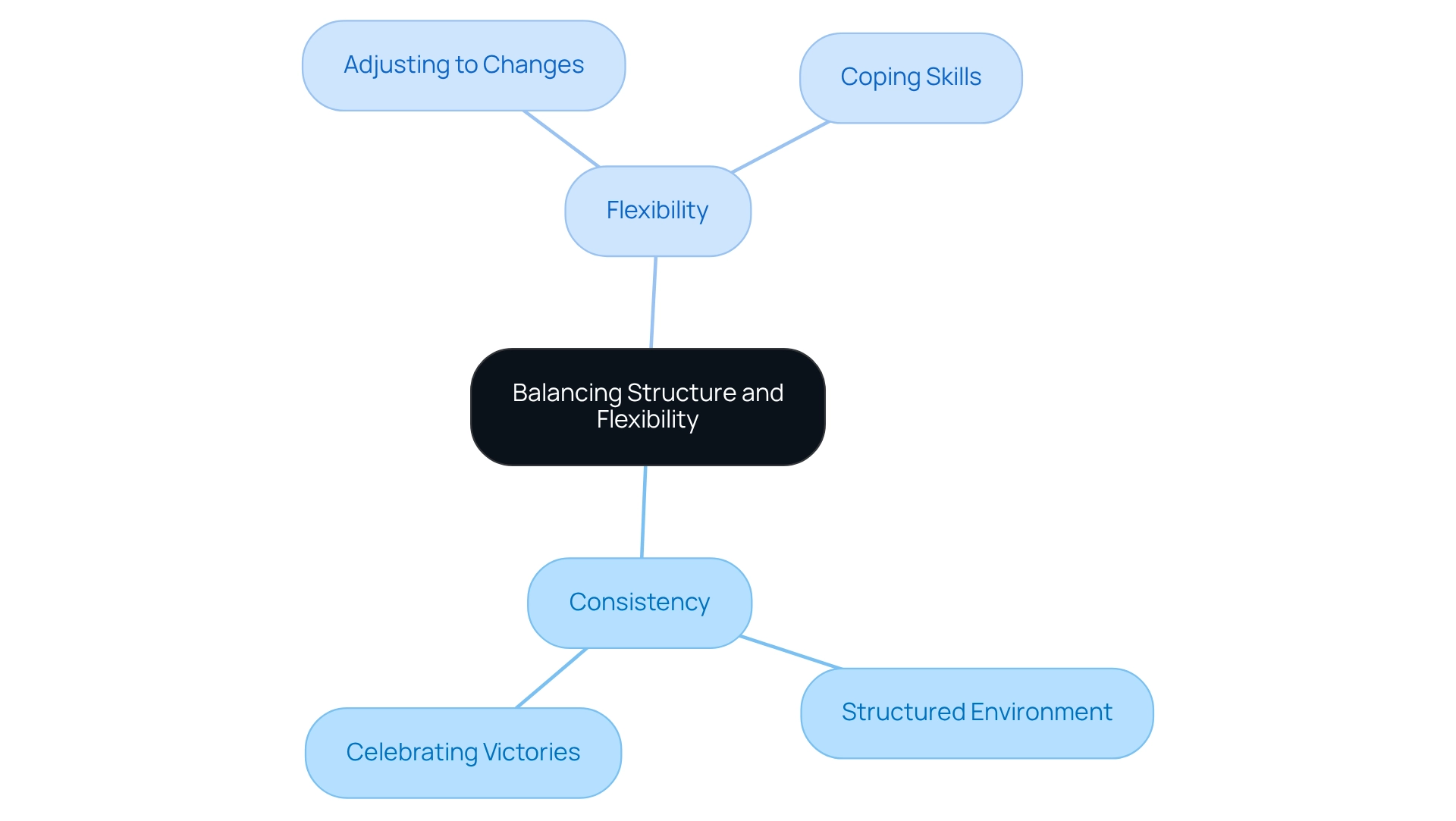
Implement Effective Communication Strategies: Foster Understanding
To enhance understanding, it’s essential for parents to use clear and straightforward language when communicating with their children. Imagine breaking down instructions into smaller, manageable steps; this approach allows young learners to process information more effectively. Moreover, providing extra time for responses can significantly improve communication outcomes. Visual aids, such as communication boards or picture cards, play a vital role in this process. They not only enhance understanding but also empower young individuals to express their needs more effectively.
Research shows that utilizing visual supports can lead to improved communication skills and social interactions for a niño con autismo, making them a crucial component of autism therapy. Consider the case studies that reveal families actively participating in these communication strategies experience remarkable improvements in their niño con autismo's ability to comprehend and respond. As highlighted by Fayge Orzel, early intervention can save an estimated $1.3 million per individual over their lifetime by reducing the need for long-term special education and intensive care. This statistic underscores the importance of effective communication strategies in fostering better outcomes.
By applying these strategies and engaging the family in the process, parents can create a supportive atmosphere that promotes enhanced understanding and communication for their children. What steps can you take today to start this journey? Share your experiences with us in the comments or through our newsletter, and let’s support each other in this important endeavor.
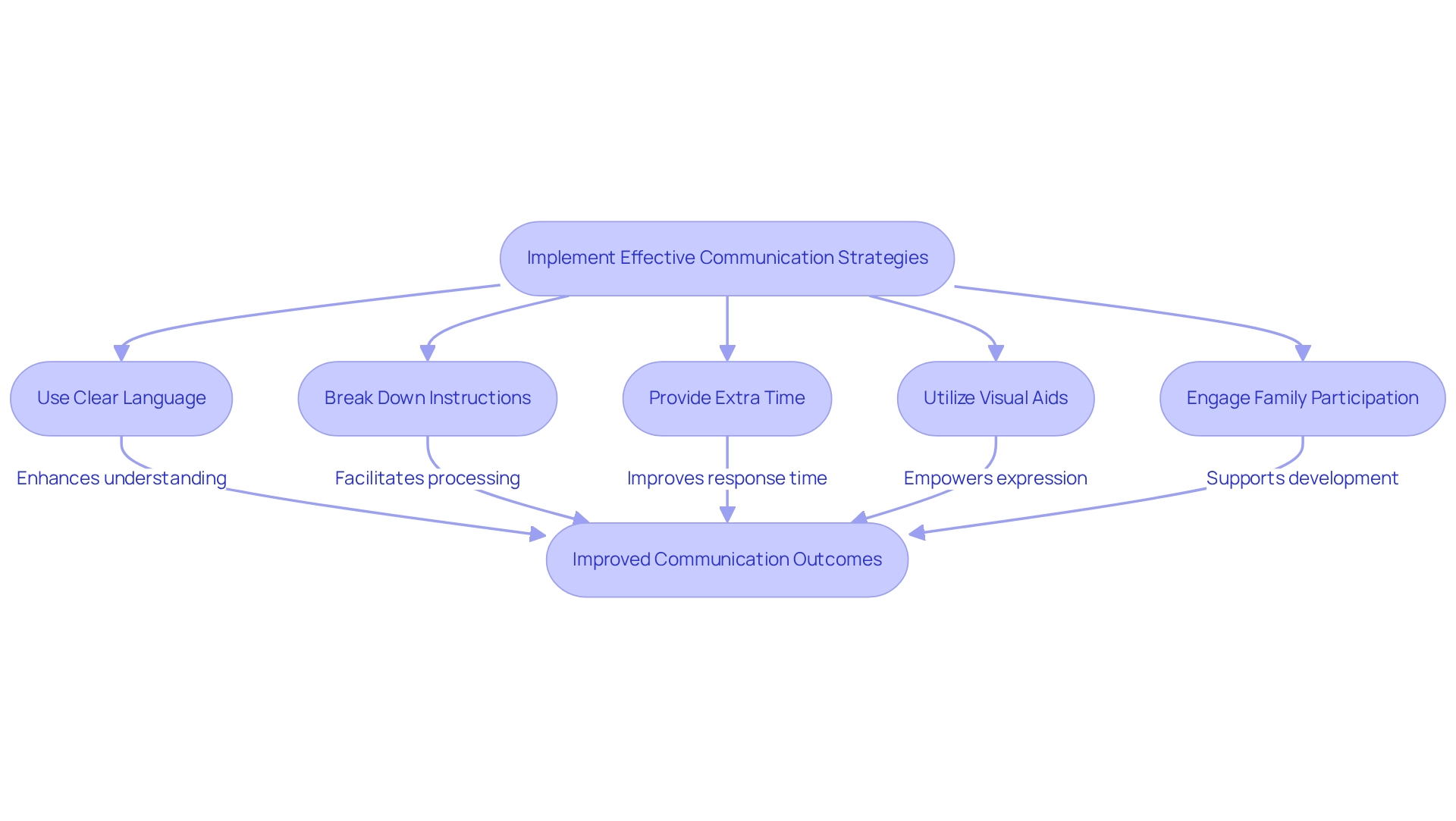
Create Sensory-Friendly Spaces: Support Comfort and Focus
Creating sensory-friendly environments at home is crucial for supporting a niño con autismo. These spaces should be thoughtfully designed to reduce sensory overload, incorporating:
- Soft lighting
- Soundproofing to minimize noise
- Comfortable seating options
Imagine your child wrapped in a weighted blanket or playing with a fidget toy; these sensory tools can greatly aid in self-regulating emotions and enhancing focus during activities. Research shows that sensory-friendly environments lead to improved behavioral outcomes, allowing young individuals to engage with their surroundings without feeling overwhelmed.
A study titled 'Future Directions for Sensory Processing Research' highlights the importance of ongoing research to develop effective interventions and educational strategies for children with atypical sensory processing. Occupational therapists emphasize that tailored environments can significantly enhance learning and social interactions. Furthermore, data indicates that sensory overload can profoundly impact a niño con autismo, making it essential for caregivers to prioritize sensory needs.
By nurturing a supportive atmosphere that promotes comfort and focus, parents can greatly enhance their children's ability to thrive. Consider sharing your experiences with others or seeking additional resources to further support your journey. Together, we can create a world where every child feels understood and empowered.
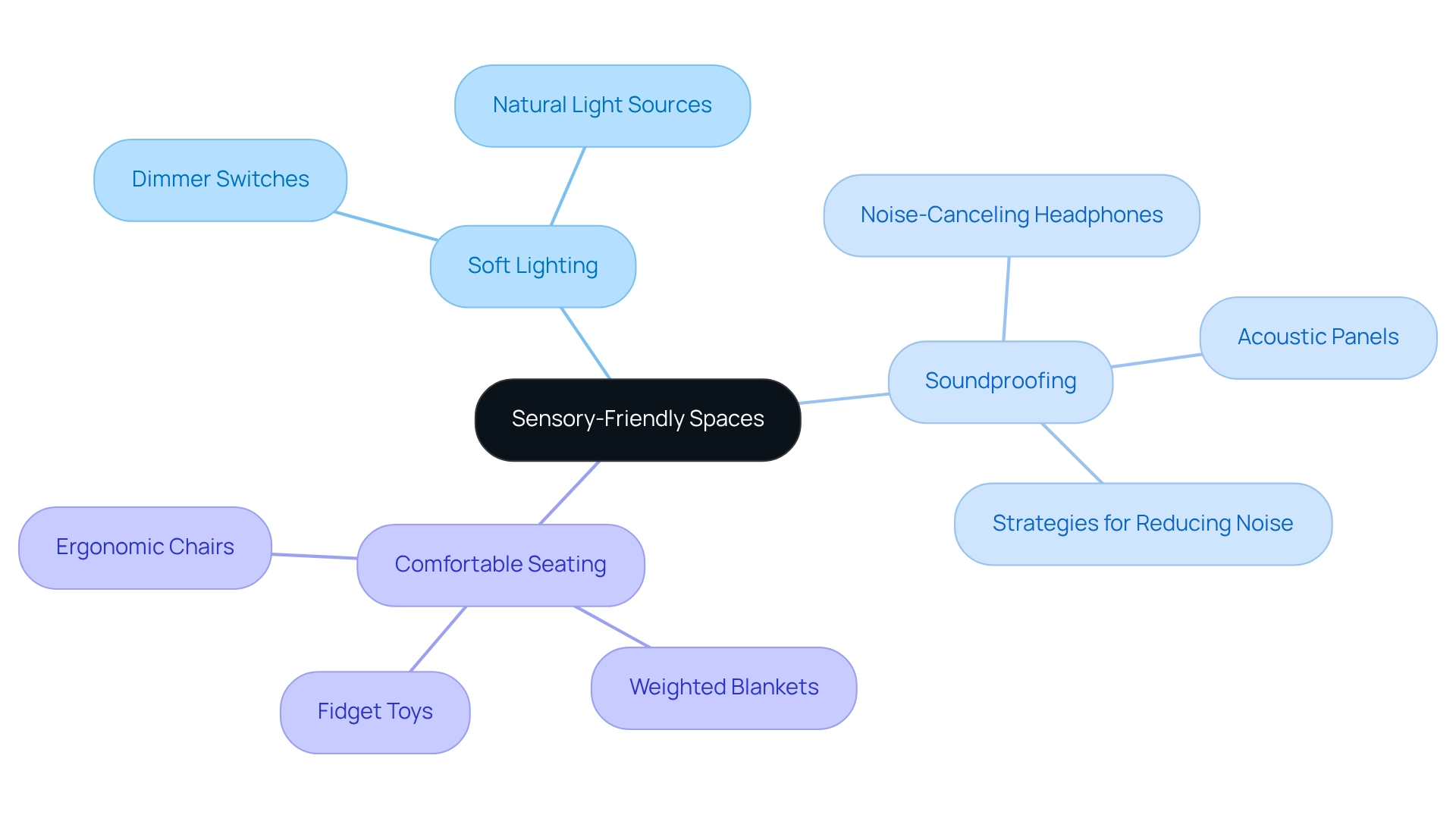
Encourage Play and Recreation: Foster Social Skills and Well-Being
Promoting play and leisure activities is essential for the development of a niño con autismo. These experiences significantly enhance their social skills and emotional control. Studies demonstrate that organized play—like group games and arts and crafts—fosters interaction and collaboration, allowing young individuals to connect meaningfully with their peers. A recent study revealed that children, specifically niño con autismo, participating in recreational activities showed marked improvements in social cognition and communication. Notably, the MBTP group exhibited significant decreases in SRS-2 total scores compared to their pre-test scores after a 12-week intervention program.
Specialists, including Temple Grandin, emphasize the importance of combining organized and free play options. She poses a thought-provoking question: 'What would occur if the gene linked to this condition were removed from the gene pool? You would have a bunch of people standing around in a cave, chatting and socializing and not getting anything done.' This underscores that such activities not only enhance social skills for a niño con autismo but also support their emotional regulation. For instance, a case study titled 'Foundation for Utilizing Physical Sports in ASD Treatment' established a practical framework for using physical sports to improve social communication and behavioral symptoms in a niño con autismo. This reinforces the importance of active engagement in recreational settings.
As we look ahead to 2025, the significance of play remains crucial, with development experts highlighting its role in fostering social skills. Organized play activities, such as team sports or cooperative games, can be particularly effective in creating a safe environment for young individuals to engage in social interactions. By prioritizing play, parents can help their children unlock their potential, nurturing both social competence and emotional well-being. So, let’s encourage our children to play, explore, and connect.
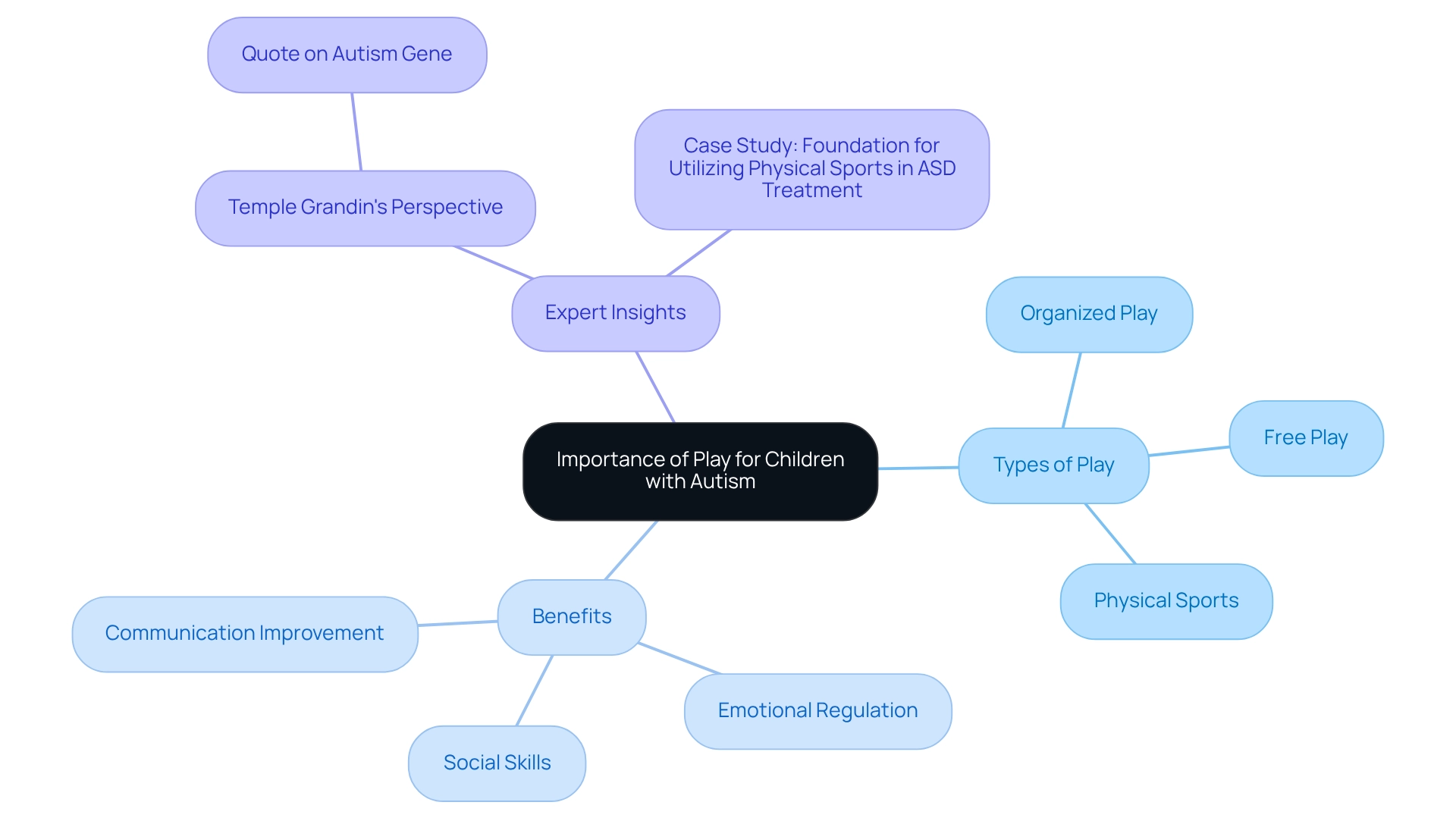
Collaborate with Educators and Therapists: Build a Support Network
Creating a strong assistance network is essential for effectively meeting the needs of a niño con autismo. Collaborating with educators, therapists, and other professionals involved in your child's care is vital. By maintaining consistent communication with these individuals, parents can stay informed about their child's progress and challenges, fostering a unified approach to support. This teamwork ensures that the strategies employed at home align with those implemented in educational settings, ultimately enhancing the overall effectiveness of interventions.
However, privacy regulations can sometimes create barriers to sharing necessary information between agencies, which may hinder effective collaboration. Research indicates that successful cooperation between parents and educators significantly improves outcomes for the niño con autismo. For example, early intervention programs have been shown to save approximately $1.3 million per individual over their lifetime by reducing the need for long-term special education and intensive care. Moreover, effective assistance networks not only empower caregivers but also cultivate an inclusive atmosphere that promotes the child's growth.
Expert insights underscore the importance of this partnership, emphasizing that when parents and educators work together, they can create a comprehensive support system that addresses the unique needs of each niño con autismo. Dr. Brenda Smith Myles notes, 'This condition is integral to the individual, not an occurrence that affected them or that can be detached from their identity,' highlighting the need for a holistic view of autism within the context of collaboration. Additionally, it is crucial to recognize the creative talents often associated with autism in areas like math, science, music, and art, which can further enhance collaborative efforts. By fostering these connections, parents can ensure that their children receive the highest quality of care and support, paving the way for their success in both academic and social environments.
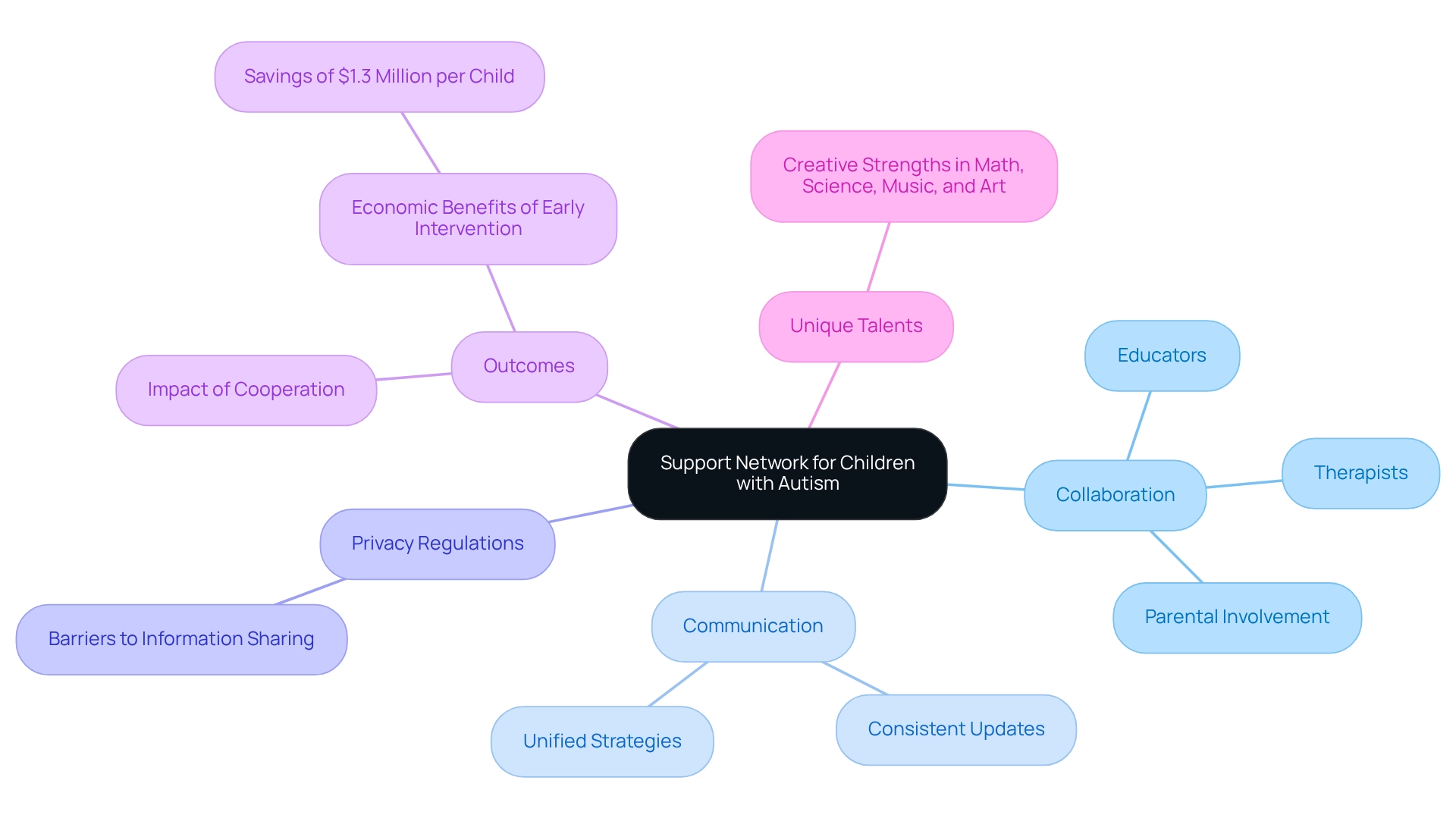
Prioritize Self-Care: Maintain Your Well-Being as a Caregiver
Caregivers of a niño con autismo face unique challenges, making it crucial to prioritize self-care to effectively meet their child's needs. Engaging in personal interests, maintaining physical activity, and seeking social support from friends or support groups are essential strategies that can make a significant difference. Mindfulness practices, such as meditation, have been shown to alleviate stress and enhance emotional resilience. This allows caregivers to navigate their challenges with greater clarity and balance.
Research indicates that caregivers of a niño con autismo exhibit higher monocyte levels compared to non-autism caregivers, suggesting they experience unique stressors that can impact their health and well-being. By incorporating self-care routines, caregivers not only enhance their own well-being but also positively influence the development of a niño con autismo. As highlighted in the case study "Mindfulness and Emotional Resilience for Caregivers," integrating mindfulness techniques into daily routines can help caregivers manage stress more effectively.
Community assistance and resources play a vital role in supporting caregivers, creating an environment where both caregivers and children can flourish. To further enhance their well-being, caregivers are encouraged to actively seek out self-care strategies that resonate with them. This ensures they remain resilient in their caregiving journey, fostering a nurturing atmosphere for their children.

Utilize Community Resources: Connect with Support Networks
Parents are encouraged to actively seek out community resources that provide essential assistance for their children with developmental disorders. Community assistance networks, workshops, and educational initiatives designed for a niño con autismo can be invaluable. Connecting with other families facing similar challenges not only nurtures a sense of community but also offers practical guidance and emotional support.
Research indicates that early screening and diagnosis significantly improve developmental outcomes, underscoring the importance of accessible resources, as highlighted in the case study "Future Directions for Autism Understanding and Support." In 2025, many community resource centers, including those in Nebraska, are enhancing their services, such as speech and occupational therapy, which can be crucial for un niño con autismo.
Furthermore, effective local support groups have been shown to alleviate feelings of isolation among caregivers, leading to improved mental well-being and resilience. As Laura NG, a Clinical Operations Manager, shares, "Through ongoing research, community initiatives, and advocacy efforts, there is hope for a future where autism is not only better understood but also more compassionately accommodated."
By connecting with these resources, parents can empower themselves and their children, unlocking potential and fostering growth.
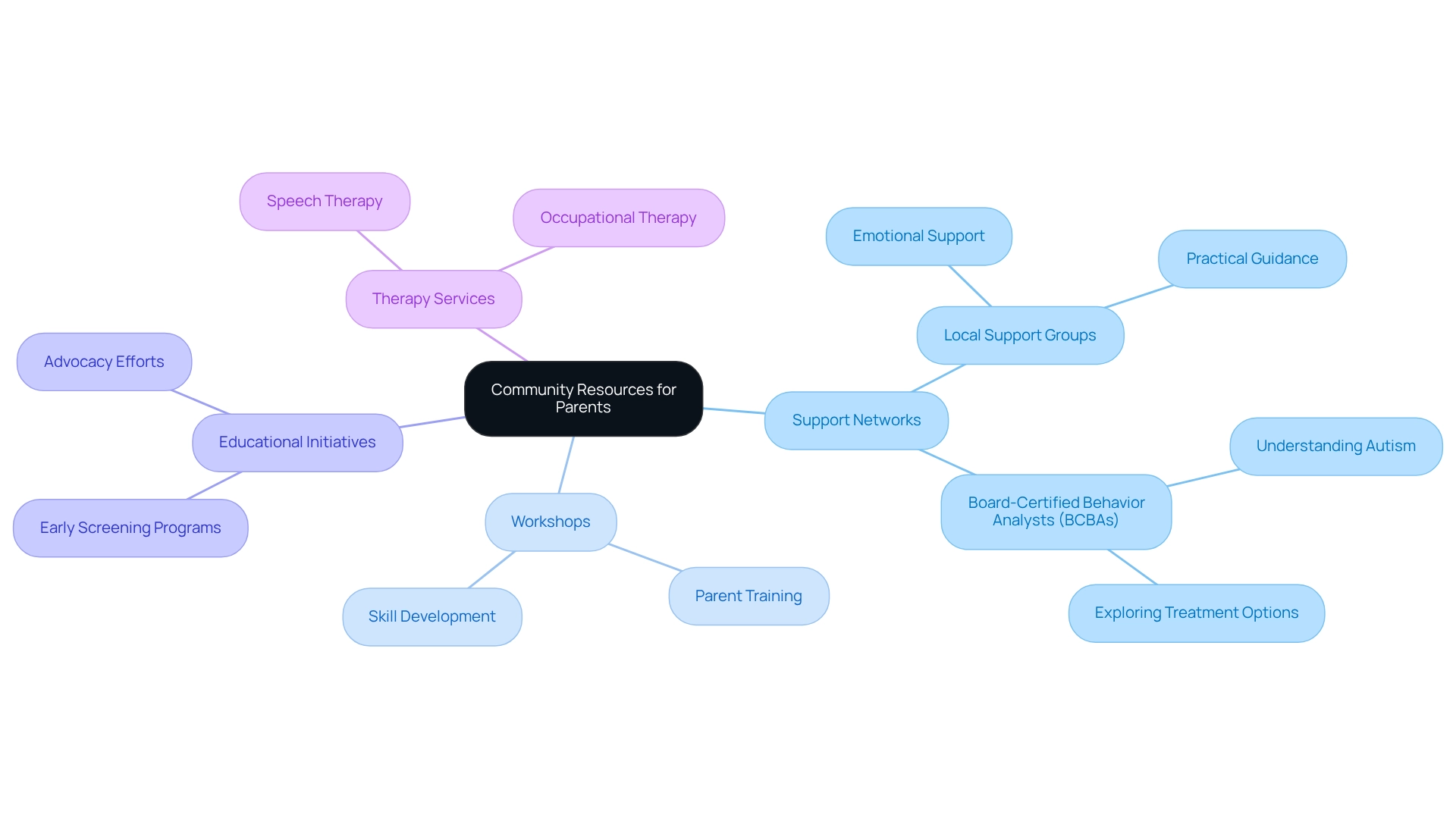
Conclusion
Creating a nurturing environment for children with autism is a journey that requires a multifaceted approach. Establishing daily routines, utilizing visual supports, and balancing structure with flexibility are essential strategies. These practices foster predictability and comfort, enhancing communication and emotional regulation. Ultimately, they empower children to navigate their world with greater confidence.
Collaboration with educators and therapists is vital on this journey. A strong support network can significantly improve outcomes. By fostering open communication and consistency between home and school, families can ensure their children receive comprehensive care tailored to their unique needs. Remember, prioritizing self-care for caregivers is equally important; when caregivers maintain their well-being, they are better equipped to support their children effectively.
Engaging with community resources can provide invaluable support and connection. By tapping into local networks, parents can share experiences and gather insights that enrich their understanding and approach to autism. Together, these strategies create a holistic framework that nurtures both the child’s development and the caregiver’s resilience. Let us continue to foster a thriving environment for all involved, where every child can flourish and every caregiver feels supported.
Frequently Asked Questions
What is ASD Media and what do they aim to achieve?
ASD Media is dedicated to enhancing the implementation of ABA therapy by providing valuable insights and strategies for caregivers and professionals. They aim to empower parents and improve outcomes for children with autism by fostering a supportive community.
How can I stay updated with ASD Media's resources?
You can subscribe to their newsletter to receive updates on the latest news and gain unlimited digital access to their resources.
What strategies does ASD Media focus on for children with autism?
ASD Media focuses on managing difficult behaviors, navigating support services, and enhancing social skills development.
Why is establishing a daily schedule important for children with autism?
A daily schedule helps children with autism understand what to expect throughout the day, which can reduce anxiety and improve their ability to complete tasks.
How can visual schedules benefit children with autism?
Visual schedules help children see planned activities, which can improve task completion and reduce anxiety levels. They also provide predictability, which is beneficial for both children and caregivers.
What challenges might families face when implementing daily routines for children with autism?
Families may encounter challenges related to immigration status, language barriers, or cultural differences that can impact the effectiveness of established routines.
How do visual supports improve communication for children with autism?
Visual aids, such as picture schedules and charts, clarify expectations and routines, empowering children to express their needs and emotions more effectively.
What evidence supports the use of visual aids for children with autism?
Research indicates that visual aids can enhance communication abilities by up to 40%, improve comprehension, and foster a more organized environment.
What is the significance of promoting diversity and inclusion in services for children with autism?
Promoting diversity and inclusion ensures that all children, regardless of their background, have equitable access to effective strategies and support, enhancing their development and well-being.




